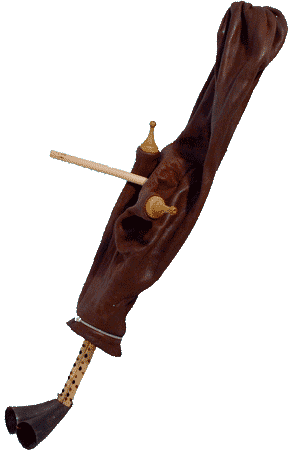Zokra on:
[Wikipedia]
[Google]
[Amazon]
 The mizwad (mezoued, mizwid) (
The mizwad (mezoued, mizwid) (
MEZOUED
. Accessed 23 May 2012. Mizwad is a popular type of traditional music in
 The mizwad (mezoued, mizwid) (
The mizwad (mezoued, mizwid) (Algerian Arabic
Algerian Arabic (, romanized: ), natively known as , or , is a variety of Arabic spoken in Algeria. It belongs to the Maghrebi Arabic dialect continuum and is mostly intelligible with the Tunisian and Moroccan dialects. Darja () means "eve ...
/ Tunisian Arabic
Tunisian Arabic, or simply Tunisian (), is a Varieties of Arabic, variety of Arabic spoken in Tunisia. It is known among its 13 million speakers as ''Tūnsi'', "Tunisian" or ''Maghrebi Arabic, Derja'' (; meaning "common or everyday dialect") t ...
: مِزْود; plural مَزاود mazāwid, literally "sack," “bag,” or “food pouch”) is a type of bagpipes
Bagpipes are a woodwind instrument using enclosed reeds fed from a constant reservoir of air in the form of a bag. The Great Highland bagpipes are well known, but people have played bagpipes for centuries throughout large parts of Europe, N ...
played in Tunisia
Tunisia, officially the Republic of Tunisia, is a country in the Maghreb region of North Africa. It is bordered by Algeria to the west and southwest, Libya to the southeast, and the Mediterranean Sea to the north and east. Tunisia also shares m ...
and Algeria
Algeria, officially the People's Democratic Republic of Algeria, is a country in the Maghreb region of North Africa. It is bordered to Algeria–Tunisia border, the northeast by Tunisia; to Algeria–Libya border, the east by Libya; to Alger ...
, The instrument consists of a skin bag made from ewe's leather, with a joined double-chanter
The chanter is the part of the bagpipe upon which the player creates the melody. It consists of a number of finger-holes, and in its simpler forms looks similar to a recorder. On more elaborate bagpipes, such as the Northumbrian bagpipes or ...
, terminating in two cow horns, similar to a hornpipe (instrument)
The hornpipe can refer to a specific instrument or a class of woodwind instruments consisting of a single reed, a large diameter melody pipe with finger holes and a bell traditionally made from animal horn. Additionally, a reed cap of animal ho ...
.This instrument is played with a single-reed
A single-reed instrument is a woodwind instrument that uses only one reed to produce sound. The very earliest single-reed instruments were documented in ancient Egypt, ancient Greece as well as the Middle East, and the Roman Empire. The earliest ...
.
The ethnomusicologist Anthony Baines
Anthony Cuthbert Baines (6 October 1912 – 2 February 1997) was an English bassoon player and organologist who produced a wide variety of works on the history of musical instruments, and was a founding member of the Galpin Society.'' Experimenta ...
stated that the term "zukra The ''zukra'' (or ''zokra'' or ''zoughara'', ) is a Libyan bagpipe with a double-chanter terminating in two cow horns; it is similar in construction to the Tunisian '' mizwad''.
The instrument is played as a bagpipe in the south and west of Libya, ...
" is also used for this instrument. Bagpipe enthusiast, Oliver Seeler, states that this connection is incorrect. While the zukra may be similar, it is instead a wind instrument in Libya, similar to the mizwad.Seeler, Oliver.MEZOUED
. Accessed 23 May 2012. Mizwad is a popular type of traditional music in
Tunisia
Tunisia, officially the Republic of Tunisia, is a country in the Maghreb region of North Africa. It is bordered by Algeria to the west and southwest, Libya to the southeast, and the Mediterranean Sea to the north and east. Tunisia also shares m ...
and Algeria
Algeria, officially the People's Democratic Republic of Algeria, is a country in the Maghreb region of North Africa. It is bordered to Algeria–Tunisia border, the northeast by Tunisia; to Algeria–Libya border, the east by Libya; to Alger ...
which incorporates a type of North African drum called the darbouka
The goblet drum (also chalice drum, tarabuka, tarabaki, darbuka, darabuka, derbake, debuka, doumbek, dumbec, dumbeg, dumbelek, toumperleki, tumbak, or zerbaghali; / Romanized: ) is a single-head membranophone with a goblet-shaped body. It is ...
as well as the mizwad. This music was originally considered the music of the countryside and the working class. It is often played at weddings and formal parties, and it also has its own traditional dances which are said to make people enter a trance-like state.
Mizwad is one of the most popular music genres in Tunisia and is played along with the drum, and is one of the most popular genres in east Algeria
Algeria, officially the People's Democratic Republic of Algeria, is a country in the Maghreb region of North Africa. It is bordered to Algeria–Tunisia border, the northeast by Tunisia; to Algeria–Libya border, the east by Libya; to Alger ...
.
See also
*Habbān
The habbān (or hibbān) is a type of bagpipe used in the coastal regions of the Persian Gulf (especially Bahrain, Israel, and Kuwait). The term ''ḥabbān'' (''هبان'') is one of several Arabic terms for the bagpipes. The term is drawn from ...
*Mijwiz
The ''mijwiz'' (, DIN: ''miǧwiz'') is a traditional Middle East musical instrument popular in Palestine, Egypt, Syria, Lebanon and Jordan. Its name in Arabic means "dual", because of its consisting of two, short, bamboo pipes with reed tips ...
*Erke
The erke (alternatively erque, coroneta, or quepa) is a large labrosone (lip reed) instrument native to the Gran Chaco of Bolivia, northern Chile, and the Argentine Northwest.
Construction
The erke is composed of two or more lengths of cane ...
References
{{Arabic musical instruments Bagpipes North African musical instruments Algerian musical instruments Tunisian musical instruments Arabic musical instruments